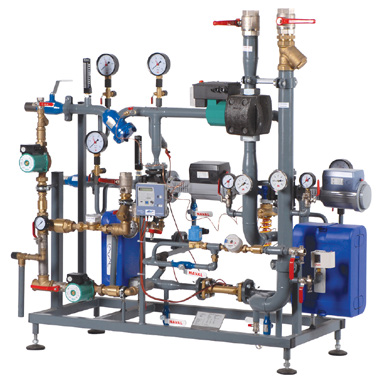A well-functioning and efficient heating network and equally distributed heat are in the common interest of district heating companies and their customers. In order to ensure ideal room temperatures and to distribute a building’s heat evenly, it is necessary to keep the heating substation and the heating system in good working order.
Environmentally friendly district heating is always available in the required quantity and time. With a modern district heating system, people do not have to worry about the heating solution for their home, because the building is evenly supplied with heat and there is no need for other heating solutions. The provision of high-quality heating services can, however, be hindered by a building’s outdated and improperly adjusted heating system and heating substation.
If the heating system is modernized and in working order, the heat is evenly distributed in the rooms and floors of a building, with no unpleasant underheating or costly overheating. A correctly adjusted heating system ensures exactly the temperature the residents want.
The heating substation is the heart of the building
The entire indoor climate of the building depends on the heating substation. It is a device that connects the building to the district heating network and transfers heat to the building’s heating system. If the building has a depreciated heating substation or lacks automation, it is worth replacing the substation with a modern, fully automatic heating substation to save money.
If the heating system has not been modernized, the components of the heating substation may be outdated, the surfaces of the heat exchanger contaminated, air may have penetrated the heating system, the system may be unbalanced, radiators unsuitable, etc. – all of which makes heating wasteful and increases heating costs. In order to work efficiently, an old heating system or its components should be replaced and the new equipment properly adjusted.
If you find that your building’s heating system or heating substation is not working correctly or is outdated, we recommend ordering a heating system inspection to assess the situation and prevent potential problems. During inspection, the heating system experts check the condition of the heating substation, pipes, and radiators, and provide an overview of the current state of the heating system as a whole. After a simple inspection, a conclusion can be drawn as to whether and what the first steps should be to ensure a better and more economical operation of the heating substation and the heating system.
What is done during the inspection of the heating system?
- The building representative is asked about the functioning of the heating system.
- The heating substation, part of the piping, and some radiators are visually inspected.
- It is checked as to which radiators are used, what condition they are in, when they were installed, and whether thermostatic valves are used.
- It is checked whether the district heating has a dependent or independent connection and whether the building uses a one- or two-pipe system.
- Information is gathered about when and of which material the heating system was built, whether it is insulated, in what condition it is, whether it is possible to balance the heating system, and whether it is possible to ventilate it.
- When the heating substation was installed, whether the components have been replaced over time, the condition of the unit, and which main components are in use are also checked.
- A short document is prepared to give an overview of the current state of the heating system.
- Guidelines are given to the building representative on whether and how to improve the heating system and what steps to take next.

Modernized district heating is convenient
Heat regulation in a district-heated building is simple and convenient thanks to automated systems. If you set the automation to the desired mode, it will adjust the heating of the building according to the outside temperature. If it is warm outside, the automation switches off the heating and reduces heat consumption, and vice versa.
Ideally, you could put a thermostat or temperature sensor in every room, but every home should have at least one. With the help of a thermostat, you can monitor the room temperature and make informed heating decisions. If the room seems cool, then it is possible to check whether the room temperature is within the norm (21-23 °C) or if the reason for feeling cool is something else.
Heating can be adjusted individually in rooms with thermostats on the radiators. If the room is warmer than normal, you could turn the thermostat down a little more. After adjusting the thermostat, it is worth checking the room temperature again the next day, because the room temperature does not change instantly. The process should be repeated until the room temperature is right. The thermostat maintains a constant temperature at all times and probably does not need to be adjusted when the outside temperature changes. When it gets colder outside, hotter water comes from the heating substation to the building’s radiators and the room temperature remains the same. Among other things, thermostats in each room help to maintain the same enjoyable indoor climate in sunny and shaded rooms.
In any case, district heating customers can be sure that their homes will be warm in any weather. All they must do is keep the heating system and heating substation of their home in order and adjust it properly.
The article was published in April 2021 in the magazine Elamu- ja Korteriühistu.



